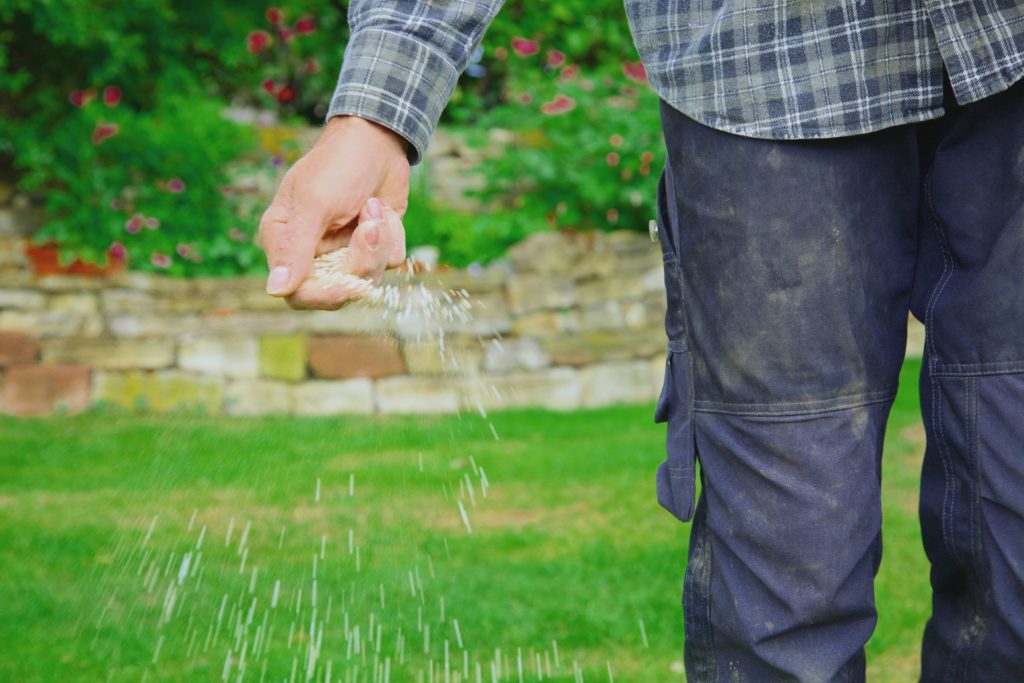Planning to add a new lawn? There are two options for installing grass – grass seed or turf. Which one is best for you?
Grass seed is the most common method of installing a lawn. Sometimes, homeowners will choose to use turf, or sod, instead.
How to Apply Grass Seed
When using grass seed to start your lawn, research and choose a grass variety that grows best in your regional climate. In Northeast Ohio, the best choice is a variety of cool season grass.
Rake the soil and add fertilizer before spreading the grass seed. After the seed is laid in the lawn, a layer of straw helps protect the budding grass.
Make sure to water regularly to encourage healthy growth.
How to Use Turf for a Lawn
Turf is a roll of grass, attached to a thin layer of dirt, which contains the roots. To add turf to your lawn, rake and use topsoil to ensure an even surface. Add fertilizer to the ground, before unrolling the turf, to help it grow.
After prepping the soil, unroll the turf, cutting any pieces necessary to fit. After applying, water the new turf regularly.
So, which is best for you – grass seed or turf? Both methods have advantages and disadvantages.
Let’s look at lawn seed vs turf and discuss the pros and cons of each method.
Pros and Cons of Using Grass Seed for a Lawn
Grass seed is the most common choice for setting a new lawn. Grass seed also is the most economical method of adding grass. Distributing the grass seed is as simple as using a spreader.
While a dependable option for developing a lawn, grass seed does have some disadvantages.
Grass seed must be planted at the right time, so it can take hold effectively. Late summer to early fall is the best time for planting grass seed. If you cannot fit planting into this window, grass might not take root and flourish.
Once grass seed is placed, it’s important to keep foot traffic off the lawn for several weeks. This can prove difficult, and cumbersome if you’re moving into a new home, for example.
It can take an entire growing season for the lawn to look completely full, so expect to use some patience when adding grass seed. Excessive rain can wash out grass seed, as well, so severe weather could be a setback.
Pros and Cons of Using Turf for a Lawn
If you’re choosing turf seed vs grass seed for your lawn, turf has one distinct advantage: it’s fast! Turf, or sod, is the quickest route to a full lawn. The turf rolls out and covers the dirt immediately, giving you the immediate satisfaction of a lush, green lawn. A turf lawn can be laid nearly anytime, as long as the grass takes root before ground freezing. And turf lawns establish faster, so you can use the lawn in approximately two to three weeks.
While turf lawns have many benefits, there are cons. When it comes to grass seed vs turf cost, turf is more expensive. This is the main reason many homeowners choose the grass seed method.
And, since the sod needs to be rolled out and fitted perfectly, it does take some skill. Installing turf yourself may not be an option, so you would need to add the cost of installation to the cost of the turf itself.
Grass seed typically takes better root than turf, so if you have shady areas and other problematic spots in your yard, you may have better luck with grass seed than with turf.
Keep Your New Lawn Looking Great
No matter how you choose to establish your lawn, maintaining your grass doesn’t need to be difficult. The Grass Master offers full-service lawn care from specialists who understand the needs of Northeast Ohio grass. Now is the time to start thinking about a greener lawn in the spring. Our deluxe lawn care package handles expert fertilization, weed and pest control. Contact Grass Master today to find out what we can do for you.

